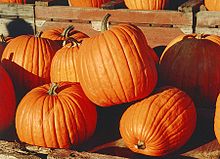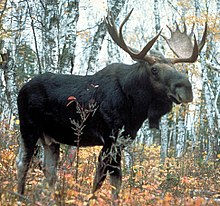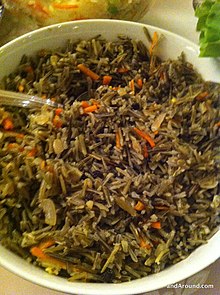
| Part of a series on |
| Native Americans in the United States |
|---|
Indigenous cuisine of the Americas includes all cuisines and food practices of the Indigenous peoples of the Americas. Contemporary Native peoples retain a varied culture of traditional foods, along with the addition of some post-contact foods that have become customary and even iconic of present-day Indigenous American social gatherings (for example, frybread). Foods like cornbread, turkey, cranberry, blueberry, hominy, and mush have been adopted into the cuisine of the broader United States population from Native American cultures.
In other cases, documents from the early periods of Indigenous American contact with European, African, and Asian peoples have allowed the recovery and revitalization of Indigenous food practices that had formerly passed out of popularity.
The most important Indigenous American crops have generally included Indian corn (or maize, from the Taíno name for the plant), beans, squash, pumpkins, sunflowers, wild rice, sweet potatoes, tomatoes, peppers, peanuts, avocados, papayas, potatoes and chocolate.[1]
Indigenous cuisine of the Americas uses domesticated and wild native ingredients.[2] As the Americas cover a large range of biomes, and there are more than 574 currently federally recognized Native American tribes in the US alone, Indigenous cuisine can vary significantly by region and culture.[3][failed verification][4] For example, North American Native cuisine differs from Southwestern and Mexican cuisine in its simplicity and directness of flavor.
|
Further information: Eastern Agricultural Complex |
|
For the American sense of the term, see Cuisine of the Southern United States. |
|
See also: Inuit cuisine |
| Indigenous peoples in Canada |
|---|
 |
|
|
Country food, in Canada, refers to the traditional diets of the Indigenous peoples in Canada (known in Canada as First Nations, Metis, and Inuit), especially in remote northern regions where Western food is an expensive import, and traditional foods are still relied upon.[5][6][7]
The Government of the Northwest Territories estimated in 2015 that nearly half of Northwest Territories residents in smaller communities relied on country food for 75% of their meat and fish intake; in larger communities, the percentage was lower, with the lowest percentage relying on country foods (4%) being in Yellowknife, the capital and only "large community".
The most common country foods in the Northwest Territories area include mammals and birds (caribou, moose, ducks, geese, seals, hare, grouse, ptarmigan), fish (lake trout, char, inconnu, whitefish, pike, burbot) and berries (blueberries, cranberries, blackberries, cloudberries).[8]
In the eastern Canadian Arctic, Inuit consume a diet of foods that are fished, hunted, and gathered locally. This may include caribou, walrus, ringed seal, bearded seal, beluga whale, polar bear, berries, and fireweed.
The cultural value attached to certain game species, and certain parts, varies. For example, in the James Bay region, a 1982 study found that beluga whale meat was principally used as dog food, whereas the blubber, or muktuk was a "valued delicacy".[9] Value also varies by age, with Inuit preferring younger ring seals, and often using the older ones for dog food.[10]
Contaminants in country foods are a public health concern in Northern Canada; volunteers are tested to track the spread of industrial chemicals from emitters (usually in the South) into the northern food web via the air and water.[11][12]
In 2017, the Government of the Northwest Territories committed to using country foods in the soon-to-open Stanton Territorial Hospital, despite the challenges of obtaining, inspecting, and preparing sufficient quantities of wild game and plants.[13]
In Southern Canada, wild foods (especially meats) are relatively rare in restaurants, due to wildlife conservation rules against selling hunted meat, as well as strict meat inspection rules. There is a cultural divide between rural and remote communities that rely on wild foods, and urban Canadians (the majority), who have little or no experience with them.[14]
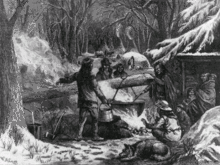
|
Further information: Three Sisters (agriculture) |
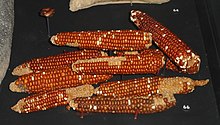
The essential staple foods of the Indigenous peoples of the Eastern Woodlands have traditionally been corn (also known as maize), beans, and squash, known as "The Three Sisters" because they were planted interdependently: the beans grew up the tall stalks of the corn, while the squash spread out at the base of the three plants and provided protection and support for the root systems.
Maple syrup is another essential food staple of the Eastern Woodlands peoples. Tree sap is collected from sugar maple trees during the beginning of springtime when the nights are still cold.[15] Birch bark containers are used in the process of making maple syrup, maple cakes, maple sugar, and maple taffy. When the sap is boiled to a certain temperature, different variations of maple food products are created. When the sap starts to thicken, it can be poured into the snow to make taffy.[16]
Since the first colonists of New England had to adapt their foods to the local crops and resources, the Native influences of Southern New England Algonquian cuisine form a significant part of New England cuisine with dishes such as cornbread, succotash and Johnnycakes and ingredients such as corn, cranberries and local species of clam still enjoyed in the region today.[17]
The Wabanaki tribal nations and other eastern woodlands peoples have made nut milk and infant formula made from nuts and cornmeal,[18][19][20] while the Cherokee nation made Kanuchi soup from hickory nuts.[21]
Southeastern Native American culture has contributed to the formation of Southern cuisine from its origins through the present day. From Southeastern Native American culture came one of the main staples of the Southern diet: corn (maize), either ground into meal or limed with an alkaline salt to make hominy, using a Native American technique known as nixtamalization.[22] Corn is used to make all kinds of dishes such as the familiar cornbread and grits.
Though a less important staple, potatoes were also adopted from Native American cuisine and have been used in many ways similar to corn. Native Americans introduced the first non-Native American Southerners to many other vegetables still familiar on southern tables. Squash, pumpkin, many types of beans, many types of peppers, and sassafras all came to the settlers via Indigenous peoples. The Virginia Algonquian word pawcohiccora means hickory-nut meat or a nut milk drink made from it.
Many fruits are available in this region. Muscadines, blackberries, raspberries, and many other wild berries were part of Southern Native Americans' diet.
To a far greater degree than anyone realizes, several of the most important food dishes of the Southeastern Indians live on today in the "soul food" eaten by both black and white Southerners. Hominy, for example, is still eaten ... Sofkee lives on as grits ... cornbread [is] used by Southern cooks ... Indian fritters ... variously known as "hoe cake", ... or "Johnny cake." ... Indians boiled cornbread is present in Southern cuisine as "corn meal dumplings", ... and as "hush puppies", ... Southerns cook their beans and field peas by boiling them, as did the Indians ... like the Indians they cure their meat and smoke it over hickory coals.
— Charles Hudson, The Southeastern Indians[23]
Southeastern Native Americans traditionally supplement their diets with meats derived from the hunting of native game. Venison has always been an important meat staple, due to the abundance of white-tailed deer in the area. Rabbits, squirrels, opossums, and raccoons are also common.
Livestock, adopted from Europeans, in the form of hogs and cattle, are also kept. Aside from the more commonly consumed parts of the animal, it is traditional to also eat organ meats such as liver, brains, and intestines. Many of the early settlers were taught Southeastern Native American cooking methods.
Indigenous peoples of the Great Plains and Canadian Prairies or Plains Indians have historically relied heavily on American bison (American buffalo) as a staple food source. One traditional method of preparation is to cut the meat into thin slices then dry it, either over a slow fire or in the hot sun, until it is hard and brittle. In this form it can last for months, making it a main ingredient to be combined with other foods, or eaten on its own.
One such use could be pemmican, a concentrated mixture of fat and protein, and fruits such as cranberries, Saskatoon berries, blueberries, cherries, chokecherries, and currants are sometimes added. Many parts of the bison were utilized and prepared in numerous ways, including: "boiled meat, tripe soup perhaps thickened with brains, roasted intestines, jerked/smoked meat, and raw kidneys, liver, tongue sprinkled with gall or bile were eaten immediately after a kill."[25]
The animals that Great Plains Indians consumed, like bison, deer, and antelope, were grazing animals. Due to this, they were high in omega-3 fatty acids, an essential acid that many diets lack.[26]
When asked to state traditional staple foods, a group of Plains elders identified prairie turnips (Pediomelum esculentum, syn. Psoralea esculenta), called timpsula or tin'psila in the Lakota language group; fruits (chokecherries, June berries, plums, blueberries, cranberries, strawberries, buffalo berries, gooseberries); potatoes; squash; dried meats (venison, buffalo, jack rabbit, and prairie chicken); and wild rice as being these staple foods.[27]
"We landed at a Watlala village 200 men of Flatheads of 25 houses 50 canoes built of Straw, we were treated verry kindly by them, they gave us round root near the size of a hens egg roasted which they call Wap-to (wapato) to eate . . . . which they roasted in the embers until they became Soft"
—William Clark, Lewis and Clark Expedition
Wapato (Sagittaria latifolia) has a number of varieties and is found growing in damp marsh area around ponds, lakes, rivers, and streams. The edible rhizomes were gathered and could be roasted in the embers of a fire, or dried, ground and the meal pressed into a cake which "served well as bread" as noted by Meriwether Lewis of the Lewis and Clark Expedition. They are known today as broadleaf arrowhead, arrowhead, duckroot, or duck-potato.
In the Pacific Northwest, traditional diets include salmon and other fish, seafood, mushrooms, berries, roots and tubers, and meats such as deer, duck, and rabbit.
In contrast to the Easterners, the Northwestern peoples are traditionally hunter-gatherers, primarily. The generally mild climate led to the development of an economy based on year-round abundant food supplies, rather than having to rely upon seasonal agriculture. Yet, Native American tribes of California still relied on storing food for winter seasons, which included "nuts, seeds, and dried meat and fish".[28] Since animals migrated, vegetation is seasonal, and also weather needs to be taken into account.
In what is now California, acorns can be ground into a flour that has at times served as the principal foodstuff for about 75 percent of the population,[29] and dried meats can be prepared during the dry season.[30] It seems that acorns and other nuts took priority among indigenous tribes because of the archaeological evidence of "mortars and pestles".[31] Grinding acorns requires a lot of resources and time to gather and process them. Which implies an area where location is more permanent. When it came to gathering acorns it took everyone in the tribe because within weeks they would become mature. There was communal participation when it came to obtaining food. Soups and bread were made from the grinding of acorns.[28]
California like other parts of the states, and across the world goes through seasonal stages. Indigenous tribes along the California region were able to use "over 500 species of plants and animals for food".[28] Before contact with indigenous tribes and colonizers, there were vast resources for subsistence that were diverse among varying regions of California.
Archaeological methods suggest the use of flames and cutting materials altered bones from rodents.[32] The presence of rodent bones in Quiroste archaeological sites suggests that the Quiroste people ate rodents. The abundance of rodents may have made them a convenient food source.
Deer and seal bones are also found in indigenous communities.[32] This means that the diet is varied, as seals are found near the coast and deer are found further inland. Indigenous tribes that were closer to inland would consume land-based animals, and those closer to the coast would consume more marine-based animals.
Other evidence is through the use of screening that found anchovies to be a source of food for indigenous people.[32] This is a valuable discovery because anchovies are difficult to come by due to their fragile bones. Indigenous cuisine is not limited to salmon as a primary source of protein.
Indigenous tribes were consuming the meat of shellfish with the implication of "bi-pitted cobbles".[31] As cuisine differs between regions so do the tools used for obtaining those proteins. In this case, the meat of shellfish required stone tools to crack open the shells. Which can lead to eating more shellfish-based cuisines.
The consumption of marrow from animal bones is evident from archaeological analyses of "hand axes made from andesitic and quartzitic cobbles".[31] Obtaining bone marrow from an animal requires both time and resources, as it is located in the center of the bone and requires extra effort to extract. When food requires extra effort to obtain, it is given more value.
The "destruction of Native California", was done by the missionaries taking over the indigenous land and clearing the environment for their own cultural foodways.[33] This caused some indigenous tribes to become dependent on missionaries for survival. Archaeological evidence shows that some indigenous tribes were eating cattle because of the reliance they had on missionaries.[34]
Although some tribes relied on the food from missionaries, they still hunted for their own food from the evidence of birds found that know to migrate to the area seasonally.[34] Although they were fed by missionaries, they required more food. That's when their own ways of foodways came into play for hunting and preparing the food they captured.
As previously mentioned there was a large variety of food available in California. However native tribes living along the confines of missionaries were only able to gather "wheat, maize, barley, and peach".[28] That's if the surrounding areas were equipped to grow them.
Food not only played an important role in subsistence but also an important role in ceremonies especially to mourn someone's death.[34] Foods not only play an important role in survival but maintain cultural costumes and traditions going for personal and generational knowledge.
The preparation for making atole was done by toasting the wheat before it was granulated.[28]
While indigenous food may appear to be a thing of the past, there are still indigenous people who are keeping their traditions alive through modern cuisine. Crystal Wahpepah sees her kitchen as a way to promote indigenous "food sovereignty and the reclamation of ancestral knowledge".[35]
Ancestral Puebloans of the present-day Four Corners region of the United States, comprising Arizona, Colorado, New Mexico, and Utah, initially practiced subsistence agriculture by cultivating maize, beans, squash, sunflower seeds, and pine nuts from the pinyon pine, and game meat including venison and cuniculture, and freshwater fish such as Rio Grande cutthroat trout and rainbow trout are also traditional foods in the region.[citation needed]
Ancestral Puebloans are also known for their basketry and pottery, indicating both an agricultural surplus that needed to be carried and stored, and clay pot cooking. Grinding stones have been used to grind maize into meal for cooking. Archaeological digs indicate a very early domestication of turkeys for food.[citation needed]
New Mexican cuisine is heavily rooted in both Pueblo and Hispano food traditions, and is a prevalent cuisine in the American Southwest, especially in New Mexico.[citation needed]
The 2002 Foods of the Southwest Indian Nations won a James Beard Award, the first Native American cookbook so honored.[36][37] Publishers had told the author, Lois Ellen Frank, that there was no such thing as Native American cuisine.[38]
Alaska Native cuisine consists of nutrient-dense foods such as seal, fish (salmon), and moose. Along with these, berries (huckleberries) and bird eggs are traditionally consumed by Alaska Natives.[39]
Seal, walruses, and polar bears are the large game that Alaska Natives hunt. Smaller game includes whitefish, Arctic char, Arctic hare, and ptarmigan.
Due to weather, edible plants like berries are only available to be consumed in the summer, so people have a diet very high in fat and protein, but low in carbohydrates.
The game that is hunted is also used for clothing. The intestines of large mammals are used to make waterproof clothing and caribou fur is used to make warm clothing.[40]


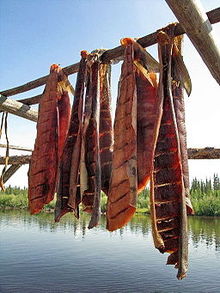


This region comprises the cultures of the Arawaks, the Caribs, and the Ciboney. The Taíno of the Greater Antilles were the first New World people to encounter Columbus. Prior to European contact, these groups foraged, hunted, and fished. The Taíno cultivated cassava, sweet potato, maize, beans, squash, pineapple, peanut, and peppers. Today these cultural groups have mostly assimilated into the surrounding population, but their culinary legacy lives on.
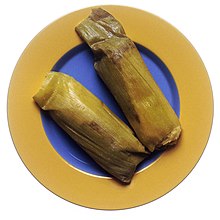

|
Main articles: Aztec cuisine and Maya cuisine |
The pre-conquest cuisine of the Indigenous peoples of Mesoamerica made a major contribution to shaping modern-day Mexican cuisine, Belizean cuisine, Salvadoran cuisine, Honduran cuisine, Guatemalan cuisine. The cultures involved included the Aztec, Maya, Olmec, Pipil and many more (see the List of pre-Columbian civilizations).




|
Main articles: Inca cuisine and Muisca cuisine |
This currently includes recipes known from the Quechua, Aymara and Nazca of the Andes.

The earliest utensils, including bowls, knives, spoons, grinders, and griddles, were made from all kinds of materials, such as rock and animal bone. Gourds were also initially cultivated, hollowed, and dried to be used as bowls, spoons, ladles, and storage containers.
Many Indigenous cultures also developed elaborate ceramics for making bowls and cooking pots, and basketry for making containers. Nobility in the Andean and Mesoamerican civilizations were even known to have utensils and vessels smelted from gold, silver, copper, or other minerals.



